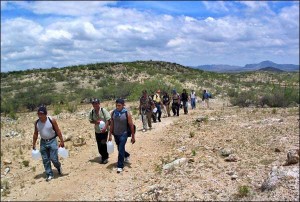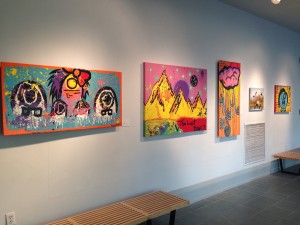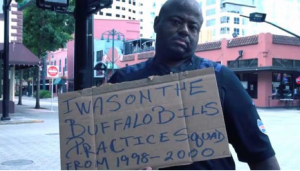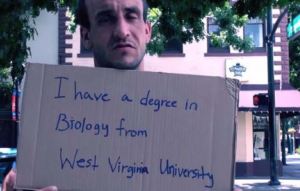Today’s post comes from Olivia Zisman, class of 2016 and Art Center Student Docent
On Friday, January 30, the Art Center’s current exhibition, XL: Large-Scale Paintings from the Permanent Collection, opened with a lecture by Joyce Kozloff whose 1972 painting Up Front, Appollonian hangs in the show. In her lecture entitled “Maps and Patterns,” Kozloff took the audience on a visual journey across states, countries, and continents as she gave an account of the various cultures from which she has drawn inspiration throughout her career
Tag Archives: pages.vassar.edu
Archaeology Sees the Homeless
Archaeologists uncover information about homeless people and immigrants based on their material culture. Their discoveries contradict popular beliefs about these groups of people. Many might not consider that homeless people have a desire to learn and think critically, but that is exactly what archaeologists discovered. The short documentary, Inocente, follows a 15-year-old homeless girl in San Diego, California. The girl, Inocente, attends school and dedicates herself to her art. Her ambition, dedication, and independence appear throughout the film, disproving stereotypes about homeless children. Like archaeology, film shows the reality of homelessness and immigration.
Inocente: Challenging Conventional Stereotypes
Inocente is a 15 year old undocumented immigrant who has lived homeless for the past 9 years. While confined to the limitations of her situation, Inocente uses artistic expression to convey her emotions, temporarily escaping the adversity that surrounds her. The documentary follows Inocente’s daily life as she interacts with her family and produces original artwork for a community show. Inocente’s life sheds new light onto the bleak stereotypes of homelessness and undocumented immigrants.
Inocente immerses her viewers into a major problem for undocumented immigrant families, domestic abuse. When asked about the major dangers undocumented immigrant families face, several thoughts emerge: being smuggled across the border; surviving the dangers deserts of the Southwest; being discovered and deported; and financial issues. These prevalent stereotypes dominate the discussion about undocumented immigrants, closing the door on the many other problems they face. Inocente shares her grim story of domestic abuse that ultimately culminated with the deportation of her father and emotional distance from her mother. This look into Inocente’s life shows that even though they are a family of undocumented immigrants, they are still a regular family with problems reflected in other American households. Thinking of undocumented immigrants as only being underpaid workers constantly avoiding deportation is a narrow-minded stereotype and Inocente’s story of her family struggles shows that undocumented immigrants are regular people too.
Inocente’s colorful expression in her artwork and passion for becoming an artist breaks from traditional stereotype of a homeless person. When thinking of a homeless person, the first images that come to mind are: dirty old clothing, expressionless faces, and begging for money on the sidewalk. This stereotype of the homeless was proven wrong within the first 30 seconds of this documentary seeing Inocente apply her daily make-up and expressing her inner creativity with unique designs and bright colors. Instead of the dark and gloomy ideas that are commonly associated with homelessness, Inocente paints bright and cartoon-like characters on giant canvases, creating her own happy world. She perseveres to better herself in other facets of her life by attending school and working to legally emancipate herself from her mother. These examples of Inocente’s drive for a better life completely shatter my previous ill-informed stereotype, showing me the realities that life as a homeless person go beyond people just sitting on sidewalks with cardboard signs begging for money.
Inocente’s story serves as a great example to the ignorance of stereotypes and the value of peeking into a 15 year old’s life to overcome those misconceptions. Although being homeless and an undocumented immigrant are forever apart of Inocente’s life, she does not let those aspects detract from her dreams of becoming an artist and being happy.
Additional Links
Published study that address how the little data in the legal, medical, and social science research fields for intimate partner violence against immigrant women: (a) increase their vulnerability for abuse; (b) are used by batterers to control and abuse immigrant women; (c) create barriers to women seeking and receiving help:
http://vaw.sagepub.com/content/8/3/367.short
Article addressing the surge of child homelessness in America:
http://www.huffingtonpost.com/2014/11/17/child-homelessless-us_n_6169994.html
Sources
“Inocente” documentary
Picture Links
http://athenacinema.com/wp-content/uploads/2014/09/inocente.jpg
The Harmful Stereotypes about Homeless People
Often people misinterpret and even forget about the homeless population of America. Throughout class we have talked about how archaeology and anthropology challenge stereotypical beliefs about homeless people. In all, archaeology can explain how homeless people are more significant and normal than people think.
In MTV’s documentary, “Inocente”, the main character does not give up to the helplessness of her surroundings and is persistent to become a world-class artist. When she was a child her Dad beat her and one day he beat her so hard her mother called the cops. The next day he was deported to Mexico. According to Inocente, this is when her homeless journey started.
It is not her fault that she is homeless and like many homeless people, she refuses to let society define her. In this case, archaeology can be used to examine Inocente’s experiences in order to realize how much she needs to move around and how she’s able to survive. The documentary reveals that Inocente’s dream to become an influential painter motivates her to live and migrate from homeless shelter to homeless.
The one thing that puzzles me is why do many Americans assume that homeless people don’t have any talent or intuition. In the documentary this wasn’t directly mentioned but Inocente’s story made me wonder why do many people believe that homeless people are worthless and loony. These certain stereotypes help destroy the identities of homeless people like Inocente.
An organization called Rethink Homelessness strives to challenge these negative stereotypes about homeless people just like the MTV documentary does. The campaign is centered on a documentary, which is about homeless people living in Florida. The campaign’s film emphasizes how homeless people can be very talented and unique. The film doesn’t tell the story of how these homeless people are homeless but instead shows the homeless people holding cardboard signs with facts written about themselves. The campaign uses these facts to destroy stereotypes that note homeless people as forlorn and proves that these people are talented and apt. Organizations like Rethink Homelessness and MTV are changing common misconceptions about homeless people and are further humanizing their identety in society (they are normal people!). So next time when you see the local hobo walking from street to street looking for shelter, don’t just assume that he or she is hopeless and nutty.
References
http://www.huffingtonpost.com/2012/07/17/inocente-mtv-homeless-immigrant_n_1679454.html
The documentary: “Inocente”
Further Reading:
http://rethinkhomelessness.org/
Video: “Cardboard Stories | Homeless in Orlando” https://www.youtube.com/watch?v=THxtcWNw3QA
Photo 2: http://heavy.com/social/2014/07/rethink-homelessness-florida-cardboard-signs-pictures/16/
Photo 3: http://heavy.com/social/2014/07/rethink-homelessness-florida-cardboard-signs-pictures/18/
Immigration reform: Obama’s new executive order and its impact on archaeology
In class this week we learned about how immigration policy in the United States has made life hell for many of those attempting to cross the border into our nation. Most of the border is protected by security, while one stretch in the harsh and unforgiving Arizona desert is left unprotected as a “natural deterrent”. Thousands of immigrants have

A group of immigrants attempting the trek across the US-Mexican border. As you can see, they are carrying plastic jugs of water to stay hydrated, although the water likely is not enough.
died in that harsh environment just trying to make it across (lots due to lack of water), and many made it here just to get deported back to their home countries. That might change soon, thanks to some recent activity at the White House.
Just this past Thursday, President Obama signed an executive order aimed at giving more protection to undocumented immigrants. According to the order, undocumented migrants who have been in the
United States for at least five years will be able to apply for a government program that protects them from being deported and allows them to work legally in the US without facing potential criminal prosecution. In addition, more migrants will be protected from deportation through reforms to the United States’ immigration enforcement system.
What does this mean for immigration into the United States, and how do we apply archaeology to this question? Well, archaeological researchers have found that immigrants are perfectly willing to undergo the trek through the desert rather than immigrate through parts of the border a with less dangerous climate but more heavily guarded by the United States border patrol. Moreover, these immigrants often depart without the supplies they need to keep a lower profile. Examples of this are the imitation Nike sneakers worn instead of hiking boots (which are not as good at protecting the feet but make them look more like Americans) and the black plastic water jugs used by some (which heat up their water but are supposedly “less visible”). An executive order making it easier for immigrants who make it across the border to stay in the country will undoubtedly make immigration to the United States more enticing for those living in Latin American nations. In addition, since this order was not accompanied by a loosening of security on the parts of the border that do not lie along the Arizona desert, the increased number of immigrants trying to cross over will undoubtedly funnel through the Arizona/Mexico border and many will die. So, Obama’s new policy will lead to not only more immigrants (who might not have before wanted to cross over into the US due to fear of deportation but now feel that they will be safe) but to more deaths in the desert. A potential solution to this problem would be to set up water stations on the border.
Sources:
http://www.sscnet.ucla.edu/soc/immigration/uploads/TestPagecrossingborder.jpg
Additional reading:
http://www.fronterasdesk.org/content/9772/movie-examines-illegal-immigration-arizona-border
http://www.nbcnews.com/storyline/immigration-border-crisis/arizona-residents-protest-arrival-undocumented-immigrant-children-n155941
http://undocumentedmigrationproject.com






